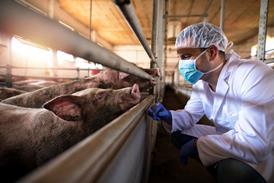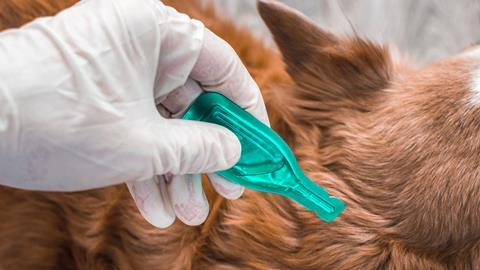Antiparasitic medicines rightly play an important role in veterinary medicine, as antiparasitic diseases can have important impacts on animal health and welfare and are economically significant. Antiparasitic veterinary medicinal products (VMPs) are evaluated under the same thorough licensing procedure as all other veterinary medicines before they are authorised, and are equally continuously monitored while they are on the market.
This article provides an overview of the current status of reflections and guidance for development of antiparasitic veterinary medicinal products, in line with the new regulation, aiming to ensure their safe and effective use and to address concerns surrounding the potential for resistance development.

Regulatory Rapporteur
October 2023 | Volume 20 | No.9
Licence notice
Copyright © 2015-2023 The Organisation for Professionals in Regulatory Affairs Ltd. T/A Regulatory Rapporteur − All Rights Reserved. This work is licensed to Christine Hetey for the purposes of academic and personal reasonable use only.
Notwithstanding this licence, no part of materials published in Regulatory Rapporteur may be reproduced without the express written permission of the publisher.
As a general rule, permission should be sought from the rights holder to reproduce any substantial part of a copyrighted work. This includes any text, illustrations, charts, tables, photographs, or other material from previously published sources.
To obtain permission(s) to re-use content published in Regulatory Rapporteur please email publications@topra.org.
To join TOPRA please click here.
Disclaimer
The views expressed in this article are the personal views of the author(s) and may not be understood or quoted as being made on behalf of or reflecting the position of the European Medicines Agency or one of its committees or working parties.
Introduction
The use of antiparasitic VMPs plays a crucial role in the treatment of parasitic diseases in veterinary medicine. They provide an important animal welfare tool for companion animals as well as for farm animals. Antiparasitic VMPs are also of significant economic importance in the livestock industry, as they contribute to limiting production losses. In addition, zoonotic parasites can seriously affect human health (e.g. Echinococcus), and treating these parasites in animals can help in preventing their spread to people.
Consequently, antiparasitic VMPs are widely used in animals, to a far greater extent than in human medicine. At the time of writing, approximately 16% (39 out of 242) of all VMPs authorised via the European Medicines Agency (EMA) (centralised procedure) were indicated against parasites (antiprotozoals, anthelmintics, ectoparasiticides and endectocides), compared to less than 1% of human medicines (two out of 1336, both antiprotozoals).
Similarly to antimicrobial substances, the wide-spread use of antiparasitic substances may lead to the development of resistance, and therefore decreased efficacy of these medicines. Resistance against some antiparasitic substances/classes has already been observed in some veterinary parasites and is of increasing concern for the animal health sector.
In recent years, this has also been recognised in legislation. Regulation (EU) 2019/6[1] on veterinary medicinal products introduces an increased focus on measures to reduce development of resistance against antiparasitic and antimicrobial medicines.However, reliable tests to determine antiparasitic resistance are currently only available for a very limited number of parasites and target animal species.
Accordingly, a significant part of the work of the Committee for Veterinary Medicinal Products (CVMP) and some of its working parties, as well as EMA’s Veterinary Medicines Division, has a renewed focus on issues associated with antiparasitic veterinary medicines and measures to avoid the development of antiparasitic resistance. This article aims to provide an overview of this work.
Authorisation of veterinary medicinal products
Antiparasitic medicines form a large subset of all authorised VMPs and generally have a very ‘active’ product lifecycle, with a comparatively high number of post-authorisation changes. The extension of existing indications to allow a wider use is often sought, for instance by increasing the range of parasites for which the treatment is indicated (such as a new tick species), by adding a new pharmaceutical form or route of administration, or by adding a new target animal species. In addition, any pharmacovigilance reports are evaluated and addressed as needed, e.g. if new adverse events (reactions) need to be added to the product information.(i)
Legislation
The EU legislation on veterinary medicinal products (Regulation (EU) 2019/6), as well as the EU legislation on medicated feed (Regulation (EU) 2019/4)[2], introduced a number of new measures aiming to reduce the risk of development of antiparasitic resistance. For instance, data on antiparasitic resistance development were already previously required when applying for authorisation of a new antiparasitic VMP. Under the new legislative requirements, this aspect must also be addressed for generic/hybrid products (copies of existing medicines). In addition, ‘antiparasitic resistance’ is now stated as a ground for refusal of a marketing authorisation application. Regulation (EU) 2019/6 also provides new incentives to marketing authorisation holders in the form of additional data protection (market exclusivity) for certain types of variations (changes to the product) that can demonstrate a reduction in the risk of development of antiparasitic resistance.
Scientific guidance
A number of specific guidance documents have been developed to ensure that antiparasitic VMPs are authorised in a consistent way across the EU and that their use is effective and safe for target animals, the environment and people in contact with the treated animals, as well as for consumers of animal-derived food.
The CVMP and its working parties also provide scientific guidance on antiparasitic VMPs and how to delay resistance development. Some examples are given below.
In 2020, the CVMP provided scientific advice to the European Commission regarding the safe and efficient administration of orally administered VMPs[3] also taking into consideration the risk of the development of antiparasitic resistance. This advice is currently being considered by the European Commission for the development of a legal act, according to Article 106(6) of Regulation (EU) 2019/6.
Since antiparasitic resistance is now a specified risk recognised in the legislation, this is also taken into consideration in other guidance documents currently under development by the CVMP. For example, the draft reflection paper(ii) on the application of Article 40(5) of Regulation (EU) 2019/6[4] concerning certain types of product developments provides details on the potential approaches that applicants could take to demonstrate a reduction in the risk of development of antiparasitic resistance. If a reduction in the risk of antiparasitic resistance is successfully demonstrated, the marketing authorisation holder then benefits from additional market exclusivity (data protection) for the (pre-)clinical data underpinning that new product development.
The CVMP’s Efficacy Working Party published two reflection papers on antiparasitic resistance: one on anthelmintics[5] and the other on resistance in ectoparasites.[6] These documents describe the current resistance situation in Europe for different animal parasites and antiparasitic VMPs and reflect the current knowledge on resistance mechanisms as well as management strategies to delay the development of resistance. They also provide recommendations for the prudent and appropriate use of antiparasitic VMPs in order to delay resistance development. Detailed guidance for applicants on the prudent use warnings to be added to the product information for antiparasitic VMPs has been included in the revised ‘Guideline on the summary of product characteristics for antiparasitic veterinary medicinal products’.[7]
A revision of the general guidance document for the demonstration of efficacy of ectoparasiticides[8] is currently in progress, and this will include more guidance relevant to resistance development. The document will be updated to include general guidance on factors that may affect the risk for resistance development and will provide recommendations on how to take account of those factors when designing and conducting pre-clinical efficacy studies and clinical trials. The CVMP’s Efficacy Working Party is also contributing to the ongoing revision of nine VICH guidelines on efficacy of anthelmintics.[9] Although anthelmintic resistance is not specifically addressed in these guidelines, the requirements to show a satisfactory level of efficacy have been reviewed and this may contribute to a decrease in the risk of development of resistance.
‘Lack of expected efficacy’ is one parameter that can be reported as an adverse event following VMP use and thereby should be monitored by marketing authorisation holders as part of their normal pharmacovigilance activities. As a possible consequence of resistance development, a VMP might not show sufficient efficacy for the intended indication in the intended target animal species. However, there could be various reasons for a lack of efficacy. The current pharmacovigilance system does not allow easy identification of a clear correlation of such reports with resistance. The development of guidance is planned on the information that should be provided when cases of lack of efficacy of antiparasitics are reported through the pharmacovigilance system, to give further details on the relevant data to be collected in order to make it easier to identify possible reasons for the lack of expected efficacy.
Since most antiparasitic VMPs can exert their activity not only against the unwanted parasites but also towards other terrestrial and aquatic organisms, environmental risk assessment also plays an important role in the assessment of antiparasitic VMPs. The CVMP Environmental Risk Assessment Working Party is therefore developing a number of guidance documents on antiparasitic VMPs that address general environmental concerns, such as the environmental risk assessment of ectoparasiticidal VMPs used in cats and dogs[10], or specific points within the assessment, e.g., higher tier testing to investigate the effects of parasiticidal VMPs on dung fauna.[11]
Other activities
The EMA’s Regulatory Science Strategy to 2025[12] acknowledges the need to engage with stakeholders to promote activities to minimise the risks of antiparasitic resistance development. In this regard, a new EMA project with a collaborating expert has been initiated to screen scientific literature for new treatment approaches/compounds with antiparasitic properties, with the focus on identifying options to avoid or decrease the development of antiparasitic resistance.
The EMA also collaborates with other institutions and regulatory authorities (European and worldwide) on the topic of antiparasitic resistance. As part of these collaborations, the EMA was involved in the drafting of a report by the World Organisation for Animal Health (WOAH, former OIE)[13] on the responsible and prudent use of anthelmintic chemicals to help control resistance in grazing livestock species. The aim of that report is to promote the prudent use of the few classes of anthelmintic substances that remain effective, with an emphasis on their use in food-producing ruminants such as sheep, goats and cattle.
The EMA has a central role within Europe for the regulation of veterinary medicines and therefore representatives of the EMA are frequently invited to attend international events, initiatives or scientific conferences as participants or speakers. Some are relevant for antiparasitic veterinary medicines, such as the action by the European Cooperation in Science and Technology (COST) on ‘combatting resistance in ruminants’; or conferences addressing parasitic diseases in honeybees, recognising their important role not only for honey production but also as pollinators for numerous crops, and antiparasitic VMPs are a valuable tool in the hive management of honeybees.
Conclusions
Antiparasitic VMPs are widely used in pets and food producing species, and, in view of increasing concerns on the development of antiparasitic resistance, it is important that they remain safe and effective to use.
In recent years, renewed efforts have been made by the EMA, its Committee for Veterinary Medicinal Products and the associated working parties to reflect evolving knowledge as well as new legislative requirements in the guidance documents that assist marketing authorisation holders intending to submit applications for antiparasitic veterinary medicines. As potential gaps in existing knowledge are filled, the EMA will continue to engage in the development of measures to ensure the safe and effective use of antiparasitic veterinary medicines, including the provision of guidance that helps to prevent or delay the development of antiparasitic resistance.
Acknowledgement
We thank all EMA colleagues who provided valuable feedback and comments which enabled the consolidation of this document.
References
(i) Summary of product characteristics (SPC), labelling and package leaflet.
(ii) A reflection paper is a document developed to communicate the current status of discussions or to invite comment on a selected area of medicinal product development or a specific topic. It can provide a framework for discussion or clarification, particularly in areas where scientific knowledge is fast evolving or experience is limited.
[1] Regulation (EU) 2019/6 of the European Parliament and of the Council of 11 December 2018 on veterinary medicinal products and repealing Directive 2001/82/EC
[2] Regulation (EU) 2019/4 of the European Parliament and of the Council of 11 December 2018 on the manufacture, placing on the market and use of medicated feed, amending Regulation (EC) No 183/2005 of the European Parliament and of the Council and repealing Council Directive 90/167/EEC
[3] EMA (2020) Advice on implementing measures under Article 106(6) of Regulation (EU) 2019/6 on veterinary medicinal products – scientific problem analysis and recommendations to ensure a safe and efficient administration of oral veterinary medicinal products via routes other than medicated feed (EMA/CVMP/508559/2019).
[4] EMA (2022) CVMP draft Reflection paper on the application of Article 40(5) of Regulation (EU) 2019/6 for certain categories of variations (EMA/CVMP/64911/2021)
[5] EMA (2017) CVMP Reflection paper on anthelmintic resistance (EMA/CVMP/EWP/573536/2013)
[6] EMA (2023) CVMP Reflection paper on resistance in ectoparasites (EMA/CVMP/EWP/310225/2014)
[7] EMA (2021) CVMP Guideline on the summary of product characteristics for antiparasitic veterinary medicinal products (EMA/CVMP/EWP/170208/2005-Rev.1)
[8] EMA (2023) Guideline for the demonstration of efficacy of ectoparasiticides (7AE17a, 1994)
[9] EMA. VICH Guidelines on efficacy of anthelmintics (VICH GLs 7, 12–16, 19–21)
[10] EMA (2022) CVMP draft Reflection paper on the environmental risk assessment of ectoparasiticidal veterinary medicinal products used in cats and dogs (EMA/CVMP/ERA/31905/2021)
[11] EMA (2021) CVMP Reflection paper on higher tier testing to investigate the effects of parasiticidal veterinary medicinal products on dung fauna (EMA/CVMP/ERA/87473/2021, 2021)
[12] EMA Regulatory Science to 2025 - Strategic reflection
[13] World Organisation for Animal Health (2021) Responsible and prudent use of anthelmintic chemicals to help control anthelmintic resistance in grazing livestock species.





























